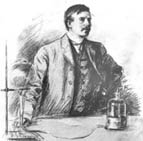 When Ernest Rutherford was told, while working on his family's farm in New Zealand, that he had won a scholarship to Cambridge University, his reaction was to stand straight and declare, "I've just dug my last potato."
When Ernest Rutherford was told, while working on his family's farm in New Zealand, that he had won a scholarship to Cambridge University, his reaction was to stand straight and declare, "I've just dug my last potato."
That ambition served him well. When the professor was hired in 1898 to work in McGill's then brand-new Macdonald Physics Building, he set his sights on characterizing the recently described phenomenon of radioactivity. He soon came to believe that the strange force was the result of the disintegration of the atom - a revolutionary concept that Frederick Soddy, a demonstrator in McGill's Chemistry Department, called akin to "a new world."
Soddy was ready to explore that world, and together he and Rutherford would collaborate on experiments that would begin to reveal the structure of the atom. So cutting edge was Rutherford's work that he had to construct the devices he used to measure atomic activity. By 1903, he published "Radioactive Change" in a London journal, a paper that opened the field of atomic physics. Rutherford's conclusion that atoms could be transformed and that each atom potentially carried a tremendous amount of energy earned him the Nobel Prize for Chemistry in 1908. Soddy would also win a Nobel Prize in 1921.
After leaving McGill, Rutherford would go on to other major breakthroughs, including splitting the atom in 1913, which he described as having "broken the machine and touched the ghost of matter."
Called "a second Newton" by no less an authority than Albert Einstein, on Rutherford's death the New York Times said "he was universally acknowledged as the leading explorer of the vast infinitely complex universe within the atom, a universe that he was first to penetrate."